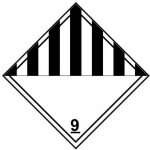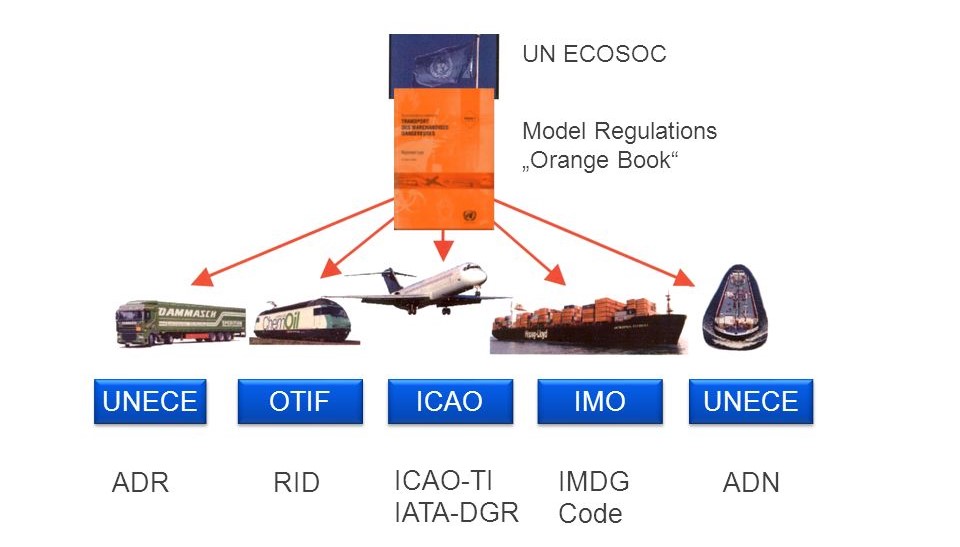Dangerous Goods Guide
‘Dangerous goods’ are materials or items with hazardous properties which, if not properly controlled, present a potential hazard to human health and safety, infrastructure and/ or their means of transport.
The transportation of dangerous goods is controlled and governed by a variety of different regulatory regimes, operating at both the national and international levels. Prominent regulatory frameworks for the transportation of dangerous goods include the United Nations Recommendations on the Transport of Dangerous Goods, ICAO’s Technical Instructions, IATA’s Dangerous Goods Regulations and the IMO’s International Maritime Dangerous Goods Code. Collectively, these regulatory regimes mandate the means by which dangerous goods are to be handled, packaged, labelled and transported.
Regulatory frameworks incorporate comprehensive classification systems of hazards to provide a taxonomy of dangerous goods. Classification of dangerous goods is broken down into nine classes according to the type of danger materials or items present, click on a class to read more details:
Explosives
Gases
Flammable Liquids
Flammable Solids
Oxidizing Substances
Toxic & Infectious Substances
Radioactive Material
Corrosives
Miscellaneous Dangerous Goods
The multitude of dangerous goods regimes across the world and the complexity of dangerous goods classifications and regulations render compliance a particularly difficult task.
CLASS 1 – EXPLOSIVES
Explosives are materials or items which have the ability to rapidly conflagrate or detonate as a consequence of chemical reaction.
Sub-Divisions
Division 1.1: Substances and articles which have a mass explosion hazard
Division 1.2: Substances and articles which have a projection hazard but not a mass explosion hazard
Division 1.3: Substances and articles which have a fire hazard and either a minor blast hazard or a minor projection hazard or both
Division 1.4: Substances and articles which present no significant hazard; only a small hazard in the event of ignition or initiation during transport with any effects largely confined to the package
Division 1.5: Very insensitive substances which have a mass explosion hazard
Division 1.6: Extremely insensitive articles which do not have a mass explosion hazard
Reason for Regulation
Explosives are capable by chemical reaction of producing gases at temperatures, pressures and speeds as to cause catastrophic damage through force and/or of producing otherwise hazardous amounts of heat, light, sound, gas or smoke.
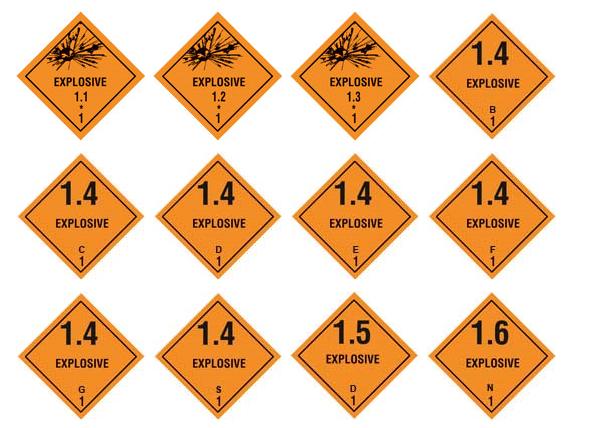
CLASS 2 – GASES
Gases are defined by dangerous goods regulations as substances which have a vapour pressure of 300 kPa or greater at 50°c or which are completely gaseous at 20°c at standard atmospheric pressure, and items containing these substances. The class encompasses compressed gases, liquefied gases, dissolved gases, refrigerated liquefied gases, mixtures of one or more gases with one or more vapours of substances of other classes, articles charged with a gas and aerosols.
Sub-Divisions
Division 2.1: Flammable gases
Division 2.2: Non-flammable, non-toxic gases
Division 2.3: Toxic gases
Reason for Regulation
Gases are capable of posing serious hazards due to their flammability, potential as asphyxiants, ability to oxidize and/or their toxicity or corrosiveness to humans.

CLASS 3 – FLAMMABLE LIQUIDS
Flammable liquids are defined by dangerous goods regulations as liquids, mixtures of liquids or liquids containing solids in solution or suspension which give off a flammable vapour (have a flash point) at temperatures of not more than 60-65°C, liquids offered for transport at temperatures at or above their flash point or substances transported at elevated temperatures in a liquid state and which give off a flammable vapour at a temperature at or below the maximum transport temperature..
Sub-Divisions
There are no subdivisions within Class 3, Flammable Liquids.
Reason for Regulation
Flammable liquids are capable of posing serious hazards due to their volatility, combustibility and potential in causing or propagating severe conflagrations.
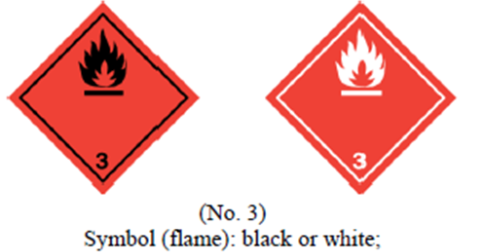
CLASS 4 – FLAMMABLE SOLIDS; SUBSTANCES LIABLE TO SPONTANEOUS COMBUSTION; SUBSTANCES WHICH EMIT FLAMMABLE GASES WHEN IN CONTACT WITH WATER
Flammable solids are materials which, under conditions encountered in transport, are readily combustible or may cause or contribute to fire through friction, self-reactive substances which are liable to undergo a strongly exothermic reaction or solid desensitized explosives. Also included are substances which are liable to spontaneous heating under normal transport conditions, or to heating up in contact with air, and are consequently liable to catch fire and substances which emit flammable gases or become spontaneously flammable when in contact with water.
Sub-Divisions
Division 4.1: Flammable solids
Division 4.2: Substances liable to spontaneous combustion
Division 4.3: Substances which, in contact with water, emit flammable gases
Reason for Regulation
Flammable solids are capable of posing serious hazards due to their volatility, combustibility and potential in causing or propagating severe conflagrations.
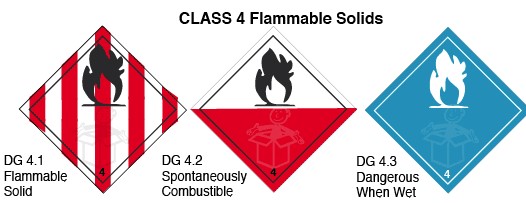
CLASS 5 – OXIDIZING SUBSTANCES; ORGANIC PEROXIDES
Oxidizers are defined by dangerous goods regulations as substances which may cause or contribute to combustion, generally by yielding oxygen as a result of a redox chemical reaction. Organic peroxides are substances which may be considered derivatives of hydrogen peroxide where one or both hydrogen atoms of the chemical structure have been replaced by organic radicals.
Sub-Divisions
Division 5.1: Oxidizing substances
Division 5.2: Organic peroxides
Reason for Regulation
Oxidizers, although not necessarily combustible in themselves, can yield oxygen and in so doing cause or contribute to the combustion of other materials. Organic peroxides are thermally unstable and may exude heat whilst undergoing exothermic auto catalytic decomposition. Additionally, organic peroxides may be liable to explosive decomposition, burn rapidly, be sensitive to impact or friction, react dangerously with other substances or cause damage to eye
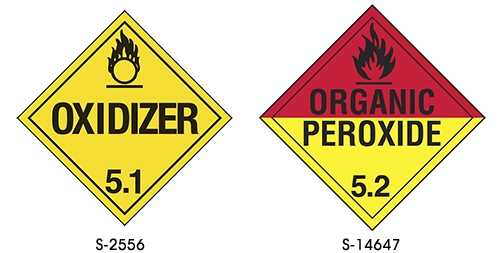
CLASS 6 – TOXIC SUBSTANCES; INFECTIOUS SUBSTANCES
Toxic substances are those which are liable either to cause death or serious injury or to harm human health if swallowed, inhaled or by skin contact. Infectious substances are those which are known or can be reasonably expected to contain pathogens. Dangerous goods regulations define pathogens as microorganisms, such as bacteria, viruses, rickettsiae, parasites and fungi, or other agents which can cause disease in humans or animals.
Sub-Divisions
Division 6.1: Toxic substances
Division 6.2: Infectious substances
Reason for Regulation
Toxic and infectious substances can pose significant risks to human and animal health upon contact.
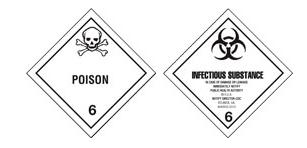
CLASS 7 – RADIOACTIVE MATERIAL
Dangerous goods regulations define radioactive material as any material containing radionuclides where both the activity concentration and the total activity exceeds certain pre-defined values. A radionuclide is an atom with an unstable nucleus and which consequently is subject to radioactive decay.
Sub-Divisions
There are no subdivisions within Class 7, Radioactive Material.
Reason for Regulation
Whilst undergoing radioactive decay radionuclides emit ionizing radiation, which presents potentially severe risks to human health.
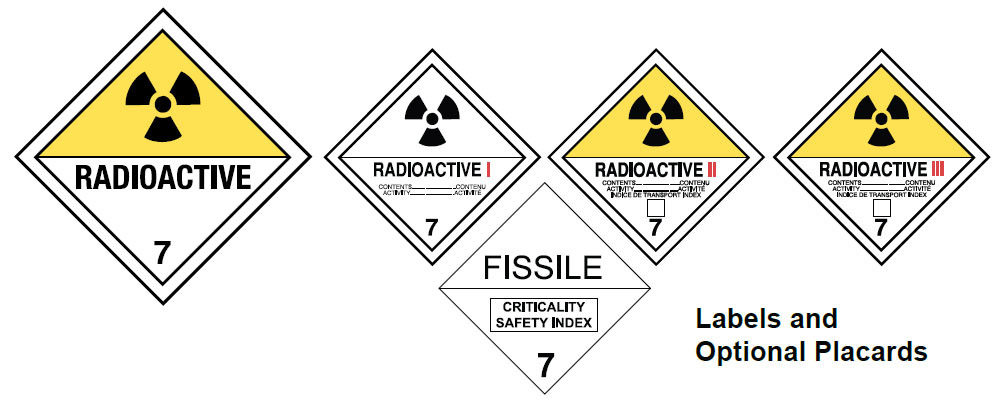
CLASS 8 – CORROSIVES
Corrosives are substances which by chemical action degrade or disintegrate other materials upon contact.
Sub-Divisions
There are no subdivisions within Class 8, Corrosives.
Reason for Regulation
Corrosives cause severe damage when in contact with living tissue or, in the case of leakage, damage or destroy surrounding materials.
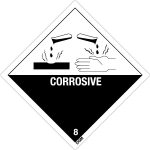
CCLASS 9 – MISCELLANEOUS DANGEROUS GOODS
Miscellaneous dangerous goods are substances and articles which during transport present a danger or hazard not covered by other classes. This class encompasses, but is not limited to, environmentally hazardous substances, substances that are transported at elevated temperatures, miscellaneous articles and substances, genetically modified organisms and micro-organisms and (depending on the method of transport) magnetized materials and aviation regulated substances.
Sub-Divisions
There are no subdivisions within Class 9, Miscellaneous Dangerous Goods.
Reason for Regulation
Miscellaneous dangerous goods present a wide array of potential hazards to human health and safety, infrastructure and/ or their means of transport.
